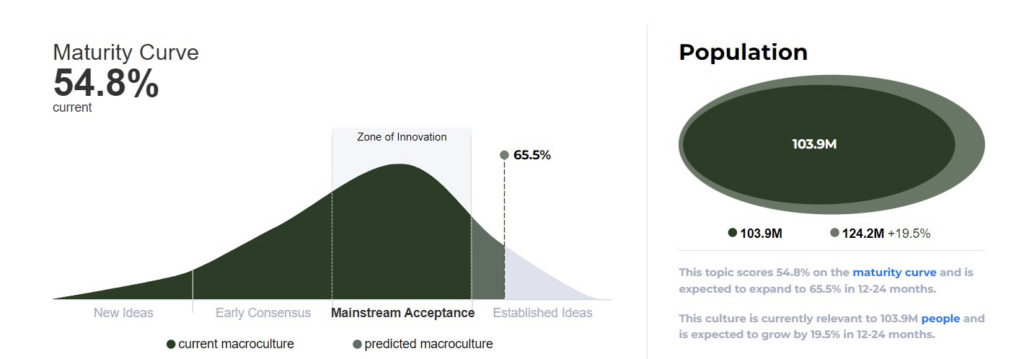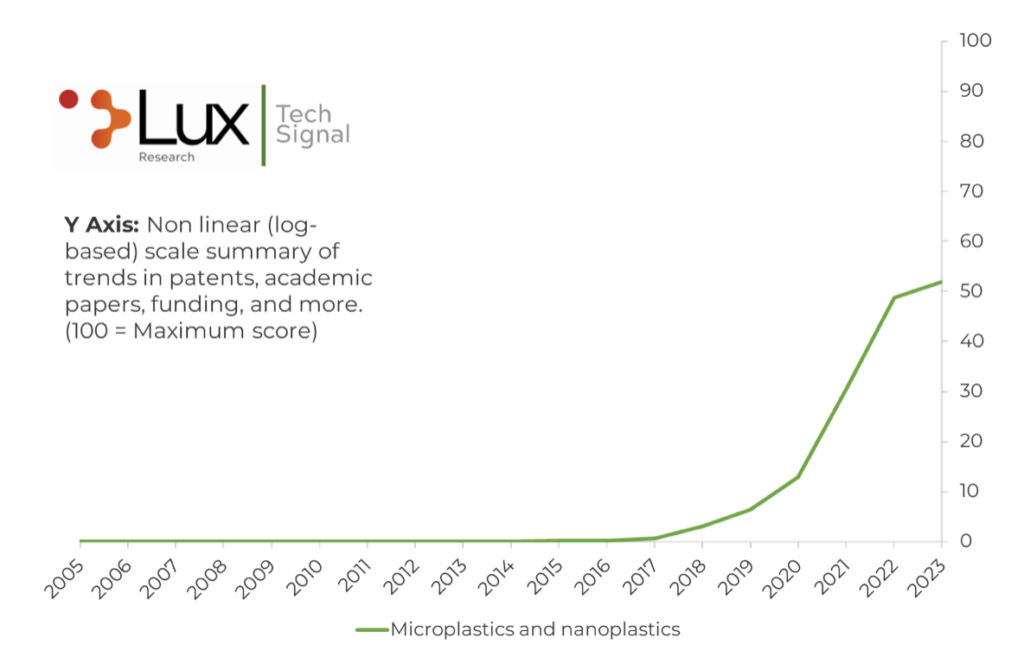If you took a survey of the chemicals industry innovation leaders, asking, “What are the biggest challenges you’re facing?” I’m pretty confident that the number one and number two issues would be decarbonization and recycling (asking executives this question is a big part of my job, so trust me). I’m sympathetic to those answers: Decarbonization is linked directly to avoiding the worst outcomes of climate change, and plastic waste has become a hugely visible issue for many consumers, which is now threatening real regulatory consequences for the chemicals industry. I don’t think many people would put microplastics at the top of that list, for a number of sensible reasons: There’s no consensus on how harmful they are, for one thing. I’m increasingly convinced, however, that microplastic pollution presents a bigger near-term threat to the chemicals industry than carbon emissions, and it may even be bigger issue than recycling. Look at the maturity curve below:

Our MotivAI tool seeks to measure the level of consensus among consumers (in this case, American consumers); what you can see is that there’s quite a high degree of consensus on the meaning of microplastics and that meaning will be fully entrenched as an established concept in the next 12–24 months. The meaning that is being entrenched is that microplastics are a significant and omnipresent health risk, both to human health as well as broader environmental health. This is significant because consumers are way ahead of both policymakers and chemical companies in a way that they’re not on issues like recycled plastic or decarbonization, which have relatively low consumer salience.
The chemicals industry response to these types of issues generally tends to be reactive — in areas like per- and polyfluoroalkyl substances (PFAS, which constitutes a similar water-based contamination issue), major action has mostly come at the behest of regulators or after major court cases. Decarbonization efforts have followed significant increases in the cost of carbon in the EU or new incentives in the U.S. Recycling efforts have come after major Chinese government action disrupted the market and began to precipitate regulatory response globally. If chemical companies follow this same playbook, they are at risk for consumer blowback: The model here should be the bisphenol A controversy, in which a whole chemical had to be formulated out of consumer products. It’s no small part of why metal water bottles are now in vogue. If consumers draw a strong link between plastic packaging and microplastics in food, it could prompt a major wave of switching from plastic to paper.
Is the chemicals industry ready? There’s some reason to be hopeful. The Lux Tech Signal for microplastics and nanoplastics, below, shows a good amount of momentum. Technologies should be ready in the 2025–2027 timeframe, which is not too far away.

However, digging a little more deeply, most of the momentum is in microplastic-free alternatives (biodegradable polymers like polyhydroxyalkanoates). These alternatives have gotten almost all the funding related to microplastics. Novel plastics have a lot of big hurdles to overcome — not the least of which is that biodegradable plastics make recycling much harder. In contrast, technologies for microplastics remediation remains underexplored; moreover, chemical companies aren’t very active investors in this area. Some technologies like PFAS remediation should cross over to help manage microplastics, but still, I think the chemicals industry is not taking this risk seriously enough. The worst-case scenario is that a microplastics backlash not only impacts the chemicals industry but derails other sustainable initiatives like recycling. The chemicals industry’s strategy has been to be reactive to policy. While policy is coming (see the upcoming EU laws or high-level policy by the UN), it’s not enough to be proactive about policy; companies need to be proactive about consumer sentiment by identifying and formulating out the worst sources of microplastics and engaging directly with microplastic cleanup efforts and technology before the backlash really starts.
